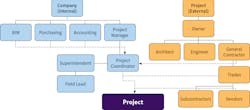n the traditional contractor model, a project was bid, awarded, and then thrown over the wall for the tradesmen to handle, according to “Optimized Operational Model for Maximizing Electrical Contractor’s Profitability” by Dr. Perry Daneshgari. In more recent years, project managers have taken on a stronger role to oversee the operations of a project, manage changes, and mitigate risks.
In today’s construction environment, projects are happening at an even faster pace, changes occur daily — sometimes multiple times a day. Even a strong project manager cannot effectively align company resources for the project, meet the demands of the general contractor (GC), keep up with changes to the drawings, help the field stay ahead of the schedule, and deal with material delays, all while also maintaining a sense of ‘control’ over the project. Project managers are stuck in a cycle of trying to meet the needs of the project one email at a time. In doing so, often become a bottleneck between the project and the company, making time for actual ‘management’ work sparse. To keep up with the professional operational model, project managers need tools and resources to more effectively work with data, rather than dealing with discrete events.
Project coordination is especially important on construction projects where:
- Several different entities are involved — many of whom may have never worked together before — and operate on different systems for communication and management.
- There is complex, interrelated work that needs to be completed sequentially.
- Project timelines are critical for completion.
To overcome the challenges of the overallocated project manager, contractors have invested in introducing new roles and new technologies to their organization to better streamline coordination within their project delivery system.
What is project coordination?
Project coordination is described as the act of ensuring communication and information-sharing among involved actors in a project, defined by “The Oxford Handbook of Project Management.” Project coordination consists of organizing people, activities, and information, so the project organization can work together to meet the needs of the customer, the company, and the project.
Who is usually involved in project coordination?
Coordination needs to happen both internally and externally during the life of the project (see Figure).
Internal coordination is needed to make sure company resources are informed of the project status and aligned to support the project. This includes project managers, procurement, prefab, field, accounting, and estimating personnel.
External coordination involves working with people who are part of the project team but external to the company, such as the GC, owner, engineers, architects, BIM leads, other trades, and suppliers/vendors.
Role & responsibilities of the project coordinator
Contractors are introducing the role of the project coordinator (sometimes also called the assistant project manager or project engineer) to their organization. The project coordinator helps coordinate all administrative duties pertaining to the project delivery process, including but not limited to correspondence with the owner, GC, vendor and field personnel, assisting with organizing and controlling the release of project order documents to support the project schedule. Some responsibilities of the project coordinator include:
1. Change orders
a. Communicate changes with the on-site superintendent.
b. Update change logs with proposal costs.
i. Review and update change logs with:
1. CBs and RFIs
2. Damages
3. GC and owner requests
c. Send updated cost letters to customers and GCs.
d. Ensure approved change orders are incorporated into the project plan.
2. Agile construction® — project execution and tracking
a. Capture/manage inputs such as percent completions into SIS® and JPAC®, change orders, accounting hours, and composite rate.
b. Conduct weekly job review meetings.
c. Communicate outputs and guide action based on productivity charts, trending, projection, composite rate trends, and reported obstacles on site.
3. Billing
a. Create and update AIAs and bill accordingly.
b. Review follow-up with field work order and bill accordingly.
4. Drawings logs
a. Archive documents, and accurately maintain drawing logs.
b. Post all addenda, RFI responses, and change orders to drawings.
c. Prepare a drawing log.
5. Schedules
a. Track and update the project schedule.
b. Monitoring project schedule.
c. Create project status reports for project managers and stakeholders.
6. Procurement
a. Complete vendor information forms.
b. Maintain procurement log.
c. Coordinate with internal purchasing personnel for the status of material deliveries.
d. Ensure purchase order numbers in absence of PO personnel.
e. Coordinate job-site deliveries.
f. Track material costs.
Improving coordination
While bringing in the role of a project coordinator or purchasing a new technology may sound like a quick fix, results cannot be achieved without the necessary structure and process to support the work and information flow. New technologies (like DCI Construction™) are being implemented to help streamline communication and visibility within organizations. The pace of construction projects is not slowing down any time soon. As expectations continue to rise, trade contractors need to consider the effectiveness of their current organizational structure and the potential strategic advantage of investing in the right resources and technology.
Dr. Heather Moore is Vice President of Operations at MCA, Inc. in Grand Blanc, Mich. She can be reached at [email protected]. Sydney Parvin is Associate Data Analyst & Technical Assistant to the VP of Operations at MCA, Inc. She can be reached at [email protected].




